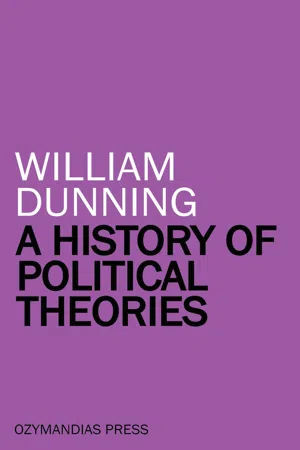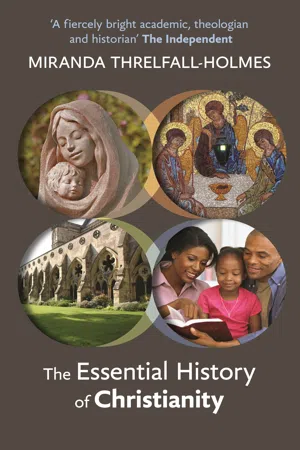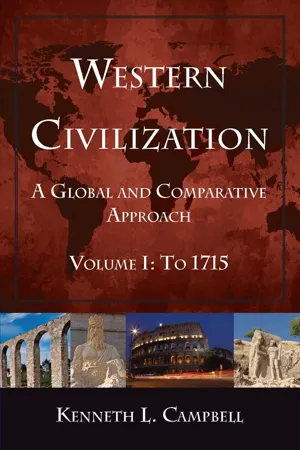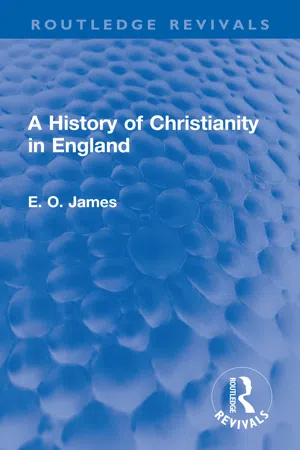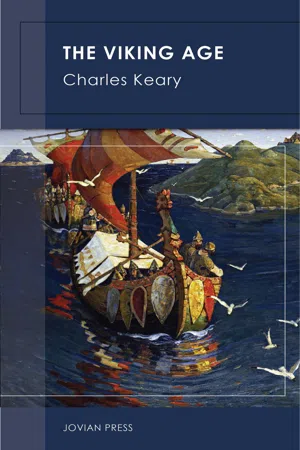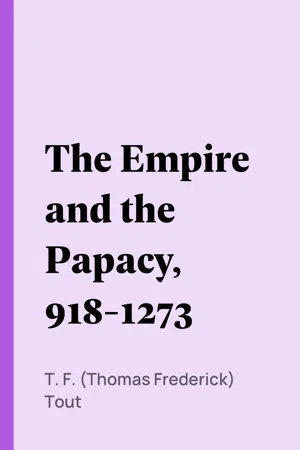Christianity in Medieval Europe
Christianity in Medieval Europe was a dominant force that shaped the religious, social, and political landscape. The Church held significant power and influence, playing a central role in people's lives through religious practices, education, and governance. The period also saw the spread of Christianity through missionary work and the construction of grand cathedrals and monasteries.
6 Key excerpts on "Christianity in Medieval Europe"
- eBook - ePub
- William Dunning(Author)
- 2018(Publication Date)
- Ozymandias Press(Publisher)
...THE DEVELOPMENT OF MEDIÆVAL INSTITUTIONS ~ 1. Christianity in the Declining Roman Empire FROM the standpoint of political philosophy the cardinal fact of mediæval history is the establishment of the Christian religion throughout and even beyond the confines of the Roman Empire, and the development of the Christian church. The govern. mental institutions of Rome were transformed, in the East by the subtle and slow-working influence of the Hellenistic spirit, in the West by the violent impact of the Teutonic nations. But in the one region as in the other Christian doctrine and ecclesiastical authority furnished the principles which dominated all conscious reflection. The astounding bankruptcy of Græco-Roman culture, manifest centuries before the political extinction of Rome, left no intellectual resource for the times of turmoil, and Europe relapsed into despairing faith and ignoble superstition. The Middle Age was unpolitical. Its aspirations and ideals centred about the form and content of religious belief. The political institutions which ultimately developed out of the wreck of the Roman Empire received their characteristic impress from this fact. And when, in the renascence of intellectual life, political speculation revived, the problem which demanded almost exclusive attention was that of disentangling the state from the church. Medi- æval political philosophy is in fact exhausted when it has propounded a theory as to the relation of secular to ecclesiastical authority. The growth of Christianity during the first three centuries of its existence is from every point of view an astonishing phenomenon. Originating in an obscure region of the Empire, among a despised and persecuted people, the creed and ritual of the Christians had become by the beginning of the fourth century the religion of the most influential classes of the Roman world...
- eBook - ePub
- Miranda Threlfall-Holmes(Author)
- 2012(Publication Date)
- SPCK Publishing(Publisher)
...4 Western Christendom: c. 1000–1500 Introduction The Church in western Europe in the Middle Ages is the sort of church that many people instinctively think of when they think of Christian history. This was indeed the time of knights, crusaders, guilds and mystery plays, illuminated Bible manuscripts, the Renaissance, the building of most of our great cathedrals, and so on. These centuries saw the establishment of ‘Christendom’ – the idea, and to some extent the reality, that Christianity and the political boundaries of nation states were inseparable, and that the legal and administrative structure of those states should embody Christian principles. This was the logical endpoint of the process started with Constantine’s conversion. Yet even as this became a political reality and a fully worked out philosophy, it was being challenged and undermined by other events and thinkers. Alongside this development, and to some extent in conflict with it, went the development of the Roman papacy as the pre-eminent international religious power. The tensions and debates that ran throughout this period as a result of these two themes foreshadowed the events of the Reformation (see Chapter 6). This was also a period of dramatic social and economic change. At the opening of the millennium, society throughout much of Europe was little changed from the basic local agricultural communities of the preceding centuries. By the end of this period, the great cities of Europe had been established, along with countless monumental churches, cathedrals, town halls and even private homes. International trade was booming, underpinned by sophisticated banking and transport infrastructures, and commercial and military confidence was such that the great European powers were beginning to look further afield for global opportunities to exploit. With all these developments came an increasing sense of a common Christian identity, especially in the face of the competing spread of the Islamic nations...
- eBook - ePub
Western Civilization: A Global and Comparative Approach
Volume I: To 1715
- Kenneth L. Campbell(Author)
- 2014(Publication Date)
- Routledge(Publisher)
...Those monasteries that did survive were seen to have compromised their original ideals during several centuries of European monastic life. Nonetheless, Christianity continued to spread and both clerics and laymen took an interest in religious reform in the tenth and eleventh centuries. The absence of strong centralized governments also had an impact on European society. Private bonds between individuals increasingly held the social structure together, assisted by the church’s increasing influence over marriage and the family. Subordinate nobles known as vassals swore allegiance to a lord and offered personal and military service in exchange for a fief (feudum in medieval Latin, hence the term feudalism) that usually consisted of a landed estate. Other personal arrangements existed between landowners and those peasants who worked the land in a system that has become known as manorialism. Although medieval Europeans did not know it at the time, across the Atlantic Ocean in what is now southern Mexico and Central America an advanced and sophisticated civilization had emerged among the Mayans. Early medieval Europe coincided with the height of Mayan civilization, commonly referred to as the Classic period, lasting from the third to the tenth centuries. Although on the surface medieval Europe and Mayan civilization were very different, an examination of Mayan politics, religion, society, and art provides an interesting basis for comparison between the two. Recent discoveries have shed light on a fascinating culture that Europeans first encountered when the Spaniards arrived in Mexico in the sixteenth century. Charlemagne On the European continent in the eighth century an emerging dynasty that later became known as the Carolingians successfully consolidated its power and replaced the ruling dynasty, the Merovingians, whose leadership had been prone to instability and royal weakness...
- eBook - ePub
- E.O. James(Author)
- 2022(Publication Date)
- Routledge(Publisher)
...CHAPTER III THE CHURCH IN MEDIEVAL ENGLAND DOI: 10.4324/9781003297574-3 T HE consolidation and unification of Western Christendom in the medieval papacy unquestionably produced temporary advantages in a turbulent age of strife and intrigue even though, as will be seen, the institution contained the seeds of its own decay. For roughly a couple of centuries after the death of Gregory VII in 1085, it was the dynamic centre of European civilization, binding together in a great spiritual commonwealth diverse types of race and culture in a common religious and ecclesiastical tradition. Feudalism arising out of a tribal state of social life lacked a centralized authority and relied on the law of force and the right of might. It separated human groups by countless divisions of allegiance and jurisdiction in a multiplicity of lordships with no permanent legislative body, judicial machinery, or political organization. To remedy these defects in the heritage from Teutonic barbarism and Celtic tribalism, a wider conception of citizenship was needed with deeper loyalties overriding all distinctions of class and nation. It was this that the medieval Church supplied with its own constitution and culture, its own law and sovereign head who claimed and maintained as of divine right supreme and absolute authority in matters spiritual and temporal. And it cannot be denied that at the height of its achievement in the thirteenth century it produced one of the greatest ages the world has ever known, despite so much that was radically wrong with the system and its institutions. To this period we are indebted for such masterpieces of architecture as Westminster Abbey in its present form, and the magnificent cathedrals of Amiens and Chartres, of Salisbury, and the superb Angel Choir at Lincoln. Among men of learning, letters and genius, the names of St. Thomas Aquinas, Grosseteste, Dante and Roger Bacon are outstanding figures, while in St...
- eBook - ePub
- Charles Keary(Author)
- 2018(Publication Date)
- Jovian Press(Publisher)
...To the historian studying the history of these growths of belief, it is a matter of very secondary importance whether a sanction for them can be found in the writings of this or that father, in the decrees of this or that council of the Church. He recognizes — that is to say, if he is at all fitted to be the historian of ideas — that Belief, like all things spiritual, is not to be expressed in set formulas nor sealed up in the tightest of decrees or articles; that it is little affected by the form of words to which a particular body of individuals may consent to append their signatures; that the belief of any age is nothing more than the sum of the individual opinions of that age, with only this proviso — that the opinion in every case is one on which its possessor is prepared to act. And therefore for a history of Christian or of any other belief he seeks for a hundred indications, in popular art, popular legend, familiar literature and correspondence, at least as important for his study as legal formulae or the decrees of councils. In three directions, it has been already said (and, indeed, the fact is generally recognized), does the development of mediaeval Catholicism chiefly display itself; towards dogma and persecution; towards monasticism; towards mysteries and orders. Using another image, we might call these the three pillars on which all that is especially characteristic of mediaeval Catholicism rests. And in the raising up of these three pillars there are necessarily certain epochs specially memorable. One — the first, perhaps — of these is the conversion of Constantine. It is not alone the acceptance of Christianity as the state religion which gives importance to that event; but the evidence which it incidentally brings to light of the extent to which the new creed had been preparing itself for that consummation, the readiness or even alacrity which it displayed to accept a kingdom which was of this world, under the accompanying conditions...
- eBook - ePub
- T. F. (Thomas Frederick) Tout(Author)
- 2020(Publication Date)
- Perlego(Publisher)
...It had extended its direct rule over a wide stretch of marchlands. The Scandinavians, Wends, Poles, Bohemians, and Hungarians all received the Christian faith from missionaries profoundly impressed with the imperial idea, and their conversion involved at least temporary dependence upon the power that again aspired to be lord of the world. At home the Emperors checked and restrained, though recognising and utilising, the feudal principle. In their fear of the lay aristocracy, no less than in their zeal for religion and order, they associated themselves closely with the work of reforming the Church. But the restoration of religion soon involved the restoration of Papacy and hierarchy, and thus they raised up the power before which Emperors were finally to succumb. Yet the Empire did not fall until it had kept central Europe together for nearly three centuries, at a time when no other power could possibly have accomplished the task. From the coronation of the Saxon to the fall of the Hohenstaufen, the Holy Roman Empire had no small claim to the lordship of the world. The Hildebrandine Reformation and the Papacy. The darkest hour of the State was the darkest hour of the Church. The last faint traces of the Carolingian revival of religion disappeared amid the horrors of Danish, Saracen, and Hungarian invasions. The feudalism that saved Europe from the barbarians now began to infect what remained of Christian life with its own ferocity, greed, and lust. The spiritual offices of the Church were becoming heritable property, dissociated from all effective spiritual duties. But amidst the turmoil of feudal times, a few nobler spirits sought salvation from the wickedness that lay thick around them in the solitude of the cloister. Before the end of the tenth century, the Cluniac revival presented to Europe an ideal of life very different from feudal militarism...
